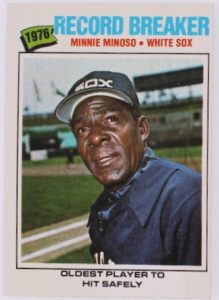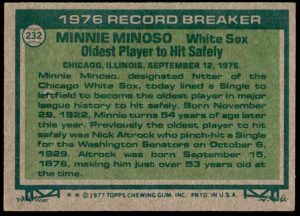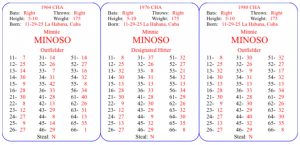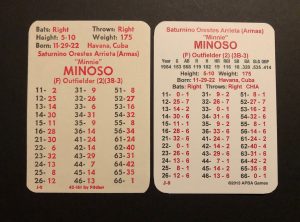Minnie Minoso was the Latin Jackie Robinson. He was the first Afro-Latino in the big leagues and was a hero to Hall of Fame players like Orlando Cepeda, Tony Perez, and Roberto Clemente. But, he also is an inspiration to current stars like Alexi Ramirez and Jose Abreu. Minoso’s impact on Major League Baseball goes far beyond his performance on the field…though that was pretty darn good in itself.
After the Dodgers signed Jackie Robinson in 1945, Orestes ”Minnie” Minoso decided to escape the sugarcane fields of Cuba and come to America. In four seasons for the New York Cubans, Minoso dominated by modeling his game after Cuban star Martin Dihigo. After the 1948 season, Bill Veeck signed Minoso for the Cleveland Indians. At the time, the Indians were coming off a World Championship season and had a hard lineup to crack. So, Minnie was sent to the San Diego Padres of the Pacific Coast League. After tearing up the PCL, he made it to Cleveland in 1949. However, Minoso didn’t establish himself in the Big League until 1951. Once he did, he was one of the best players of the decade after he was traded to the Chicago White Sox. From 1951-1964, Minoso made seven All-Star teams, won three Gold Gloves (when they were established in 1957), and received many MVP votes. From 1951-1961, Minnie averaged a .305 average with 16 homers and 18 steals. He would lead the AL in steals and triples three times apiece. Minoso was consistently in the top ten in on-base percentage throughout the 1950s, proving that he was one of the top players in the AL during the 1950s.
There is one painful category Minoso lead a record ten times…hit by pitch. In all, he was plunked 192 times in his career, ninth all-time. It’s true that Minoso crowed the plate, leading to many hit by pitches. However, he also had to deal with the racism that other pioneering players of color endured. On eight occasions, Minnie was hit in the head. One of the beanings left his skull fractured in multiple places. Minnie Minoso was a warrior.
| I | Split | G | GS | PA | AB | R | H | 2B | 3B | HR | RBI | SB | BB | SO | BA | OBP | SLG | OPS | HBP | SH |
|---|---|---|---|---|---|---|---|---|---|---|---|---|---|---|---|---|---|---|---|---|
| 1964 Totals | 30 | 2 | 38 | 31 | 4 | 7 | 0 | 0 | 1 | 5 | 0 | 5 | 3 | .226 | .351 | .323 | .674 | 1 | 1 |
In his first final season in 1964, Minnie Minoso made just 38 plate appearances, mainly as a pinch-hitter. His APBA card isn’t the worst final card, but it’s nothing to brag about. However, it’s got a couple of good things going for it. First, it’s got a 66-1. Next, it’s got four 14s, so it’s got a reasonable chance to get on base. Finally, it’s got a 42, which shouldn’t be surprising since Minoso was frequently hit by pitches. The hit by pitch Minnie took in 1964 would be the last of his career. After the 1964 season, Minoso would spend the next ten years playing in the Mexican League. Then, in 1976, Bill Veeck had an idea.
| Split | G | GS | PA | AB | R | H | 2B | 3B | HR | RBI | SB | CS | BB | SO | BA | OBP | SLG | OPS | TB | HBP |
|---|---|---|---|---|---|---|---|---|---|---|---|---|---|---|---|---|---|---|---|---|
| 1976 Totals | 3 | 3 | 8 | 8 | 0 | 1 | 0 | 0 | 0 | 0 | 0 | 0 | 0 | 2 | .125 | .125 | .125 | .250 | 1 | 0 |
In September 1976, the Chicago White Sox were a bad team and on their way to 97 losses. Veeck, always a master promoter, decided to give Minoso a chance to play in his fourth decade. Minnie managed to get a single off Sid Monge of the California Angels, making him the oldest player to get a hit in a Big League game. It even prompted Topps to make a special card for Minoso.
Minnie managed to get a single off Sid Monge of the California Angels, making him the oldest player to get a hit in a Big League game. It even prompted Topps to make a special card for Minoso.  Of course, Minoso’s age has always been a question. At the time, he was thought to be 54 years old. However, he might have been 50. Minoso was born sometime between 1922 and 1925. Even after his death in 2015, Minoso’s age is still in question.
Of course, Minoso’s age has always been a question. At the time, he was thought to be 54 years old. However, he might have been 50. Minoso was born sometime between 1922 and 1925. Even after his death in 2015, Minoso’s age is still in question.
Minnie Minoso appeared again for the Chicago White Sox in 1980, joining Nick Altrock as the only MLB players to appear in five decades. In 1980, Minoso was hitless in two pinch-hitting opportunities. There was the talk of him making an appearance in 1990, but Fay Vincent said he would not allow it because it would be a publicity stunt and hurt baseball’s integrity…he was probably right.
The two publicity stunt appearances hurt Minnie Minoso Hall of Fame candidacy. Like Jackie Robinson, Minoso didn’t play in the Big League until he was 28-years old. Because of his time in the Negro Leagues, he lost between two and five MLB seasons. Therefore, Minnie never had the opportunity to accumulate milestone Hall of Fame statistics, like 3,000 hits. However, when you consider Minoso’s peak WAR in comparison to Hall of Fame left fielders, he stacks up nicely. His peak WAR ranks ahead of 11 of the 19 enshrined left fielders. That includes players like Jesse Burkett, Joe Medwick, and Willie Stargell. In many ways, Minnie Minoso’s career is similar to Larry Doby’s. Minoso had a higher lifetime batting average (.298 to .283) than Doby. However, Doby was a much better power hitter. Yet, their career OPS+ ratings are very similar: Doby’s was 136 and Minoso’s was 130. It took the Hall of Fame an extra 31 years to induct Larry Doby. Fortunately, he had five years to enjoy his enshrinement before his death. Unfortunately, Minnie Minoso will never get to enjoy induction into the Baseball Hall of Fame. Even so, I hope the Golden Days Era Committee seriously considers him in 2021. Minnie Minoso clearly belongs in the Baseball Hall of Fame, not just for his on-field accomplishments but also for his historical importance to baseball. As Alexi Ramirez said, “Without Minnie, without his courage to leave Cuba for the major leagues, without his willingness to accept taunts and slights, none of us would be major leaguers.” If the Hall of Fame inducts this bonafide star of the Integration Era, then a glaring wrong will finally be corrected






“Minnie Minoso appeared again for the Chicago White Sox in 1980, joining Nick Altrock as the only MLB players to appear in five decades.”
According to baseball-reference – Altrock only played in FOUR decades. 1890’s, 1900s, 1910s, 1920s.
Oops – My mistake. He PITCHED in 4 decades. He also batted in the 1930s. Sorry for my error
Yep…
Last MLB appearance
October 1, 1933, for the Washington Senators